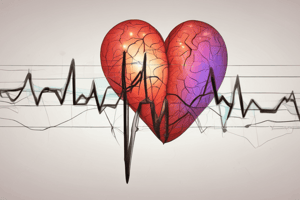Podcast
Questions and Answers
What is a key characteristic of systolic dysfunction in heart failure?
What is a key characteristic of systolic dysfunction in heart failure?
- Reduced ejection fraction (correct)
- Dilated right atrium
- Increased ejection fraction
- Normal left ventricular dimensions
What should be the first-line treatment for patients with certain types of heart conditions?
What should be the first-line treatment for patients with certain types of heart conditions?
- Medication for fluid retention
- ICD (Implantable Cardioverter Defibrillator) (correct)
- Septal myectomy for all cases
- Ventricular dilation therapy
Which of the following is NOT a characteristic of restrictive cardiomyopathy (RCM)?
Which of the following is NOT a characteristic of restrictive cardiomyopathy (RCM)?
- Dilated heart chambers (correct)
- Presence of an S4 heart sound
- Hypertension not being the cause
- Jugular venous distension (JVD)
What is the highest yield cause of amyloidosis relevant to restrictive cardiomyopathy?
What is the highest yield cause of amyloidosis relevant to restrictive cardiomyopathy?
Which symptom is more commonly associated with diastolic dysfunction rather than systolic dysfunction?
Which symptom is more commonly associated with diastolic dysfunction rather than systolic dysfunction?
What is the defining characteristic of dilated cardiomyopathy?
What is the defining characteristic of dilated cardiomyopathy?
Which sign is commonly associated with restrictive cardiomyopathy?
Which sign is commonly associated with restrictive cardiomyopathy?
In patients with restrictive cardiomyopathy, which condition can lead to abnormalities in protein deposition?
In patients with restrictive cardiomyopathy, which condition can lead to abnormalities in protein deposition?
What heart sound may be present in restrictive cardiomyopathy due to increased ventricular stiffness?
What heart sound may be present in restrictive cardiomyopathy due to increased ventricular stiffness?
What is the effect of diastolic dysfunction on left ventricular end-diastolic volume (LVEDV)?
What is the effect of diastolic dysfunction on left ventricular end-diastolic volume (LVEDV)?
Flashcards
Systolic Dysfunction in Dilated Cardiomyopathy (DCM)
Systolic Dysfunction in Dilated Cardiomyopathy (DCM)
Reduced ejection fraction, typically below 30%, indicating that the heart is not pumping blood effectively.
Septal Myomectomy
Septal Myomectomy
A procedure used to remove a portion of the left ventricular septum, reducing the pressure gradient in the outflow tract.
Diastolic Dysfunction in Restrictive Cardiomyopathy (RCM)
Diastolic Dysfunction in Restrictive Cardiomyopathy (RCM)
Heart muscle stiffens, making it difficult for the heart to relax and fill with blood during diastole.
S4 Heart Sound in RCM
S4 Heart Sound in RCM
Signup and view all the flashcards
Jugular Venous Distention (JVD) in RCM
Jugular Venous Distention (JVD) in RCM
Signup and view all the flashcards
Dilated Cardiomyopathy (DCM)
Dilated Cardiomyopathy (DCM)
Signup and view all the flashcards
Restrictive Cardiomyopathy (RCM)
Restrictive Cardiomyopathy (RCM)
Signup and view all the flashcards
Study Notes
Ventricular Dysfunction
- Ventricular dilation can be isolated or diffuse, affecting all four chambers.
- A key characteristic is systolic dysfunction, where ejection fraction is reduced (e.g., 30%).
- Septal myectomy may be considered if the left ventricular outflow tract pressure gradient exceeds 50 mmHg.
- Implantable cardioverter-defibrillator (ICD) is usually the initial treatment.
- Dilated cardiomyopathy (DCM) can have a multifactorial etiology.
Diastolic Dysfunction (Heart Failure)
- Heart failure can arise from diastolic dysfunction, even without hypertension as a cause.
- Jugular venous distension (JVD) is a hallmark sign of restrictive cardiomyopathy (RCM).
- An S4 heart sound may also be present in RCM.
- Cardiac dilation is not a feature in RCM.
- High-yield causes of RCM include:
- A history of radiation therapy (leading to fibrosis).
- Amyloidosis (protein deposition in abnormal locations).
- Hemochromatosis (iron overload).
- The presenting condition (e.g., dilated or non-dilated heart) guides diagnosis; don't rely on a single cause being linked to only one type of cardiomyopathy.
- Amyloidosis, frequently linked to multiple myeloma, is a key factor in RCM.
- RCM, like hypertrophic cardiomyopathy (HCM), demonstrates decreased values in:
- Ejection Fraction (EF)
- Left Ventricular End-Diastolic Volume (LVEDV)
- Left Ventricular End-Diastolic Pressure (LVEDP)
- To differentiate DCM from RCM, consider clinical findings:
- DCM is associated with a large cardiac silhouette, an S3 heart sound, and a lateralized apex beat.
- RCM is characterized by JVD, an S4 heart sound, and no lateralized apex beat.
Studying That Suits You
Use AI to generate personalized quizzes and flashcards to suit your learning preferences.




